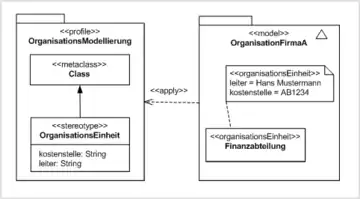Profile diagram
In the field of software engineering, a profile diagram operates at the metamodel level to show stereotypes as classes with the «stereotype» stereotype, and profiles as packages with the «profile» stereotype.[1] The extension relation (solid line with closed, filled arrowhead) indicates what metamodel element a given stereotype is extending.

Example for the definition and usage of a simplified profile for organisation modelling purposes.
| UML diagram types |
|---|
| Structural UML diagrams |
| Behavioral UML diagrams |
History
The profile diagram did not exist in UML 1. It was introduced with UML 2 to display the usage of profiles. Before its introduction, other diagrams had been used to display this issue.[1]
See also
References
- Christoph Kecher: "UML 2.0 - Das umfassende Handbuch" Galileo Computing, 2006, ISBN 3-89842-738-2
This article is issued from Wikipedia. The text is licensed under Creative Commons - Attribution - Sharealike. Additional terms may apply for the media files.
